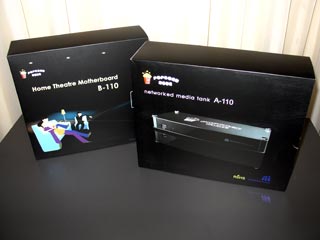 In March we took a look at the original Popcorn Hour A-100 and it quickly became our in-house media playback device of choice. Sure, it wasn’t perfect – but its near flawless display of 1080p content, along with its incredible ability to playback almost every file we threw at it, made us sit up and take notice.
In March we took a look at the original Popcorn Hour A-100 and it quickly became our in-house media playback device of choice. Sure, it wasn’t perfect – but its near flawless display of 1080p content, along with its incredible ability to playback almost every file we threw at it, made us sit up and take notice.
Now, less than five months later, Syabas has announced two new Popcorn Hour models which we have been lucky enough to get our digital hands on.
Read on for our experiences with the new Popcorn Hour A-110 and B-110 NMTs as well as a comparison and update on our take of the original A-100 Network Media Tank.
In their own way, all the Popcorn Hour models are very similar. To the untrained eye, the A-100 and the A-110 are nearly identical. Both units share the same case and bar a few minor technical changes, look exactly the same. By contrast, the B-110 is a Mini-ITX variant of their Popcorn hardware – and while functionally similarly, it looks completely different.
Package Contents
|
A-100 |
A-110 |
B-110 |
|
Popcorn Hour A-100 |
Popcorn Hour A-110 |
Popcorn Hour B-110 Baseline (Mini-ITX motherboard) |
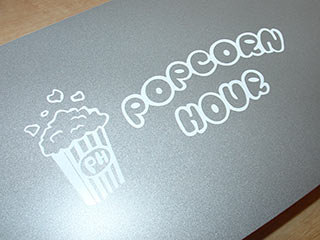 The A-100 Revisited
The A-100 Revisited
Before we get to the specifics of the two new models, it is worth updating our experiences with the original Popcorn Hour A-100 unit.
Our original review discussed the Popcorn Hour as a high definition replacement of the aging XBOX Media Centre platform – which at the time – was only available on the original Xbox hardware. While we are aware XBMC has evolved and moved on to juicier hardware, five months on, we can still say we are smitten by our little NMT.
Since our review we have purchased a Pioneer Kuro 1080p plasma which has really brought out the best from the A-100. We have played back hundreds of videos of varying formats and while our five problematic files has grown some – AC3 in a WMV container continues to frustrate – the A-100 has become a fundamental part of our reference home theater. Having said this, we would still rate the A-100 with a 90-95% success rate when playing back common medium/high quality digital video files.
Firmware updates have been released nearly every month and with them a steady set of improvements. Subtitle support has improved, as has scanning forward and backward in MKV files. Simple skinning support has been implemented but despite many bugs having been squashed, we have to admit that the unit still requires the old “pull the power cable out” reset, from time to time. Even with skinning support, the interface remains plain and bookmarking for files other than DVD ISOs still remains unfulfilled. Another item that was on our future firmware wish list was playback from within RAR files which also has failed to materialize.
While regular firmware updates have helped, we also remedied some of the unit’s bugs ourselves; using not only the Popcorn Hour online forums but also our simple ingenuity. A month or so after the published review, we came across a few 1080p MKV files which refused to play smoothly over our wired network connection. Consulting the forums, we quickly came across a helpful post about how to improve network performance by setting up NFS. And it worked. Setting our network shares from the simple – but slow – SMB protocol, to the more efficient – but cumbersome tp setup – NFS protocol solved our problem and incidentally drastically shortened the “buffering” time. We also got around to installing a 250GB 2.5” laptop hard drive (along with a suitable 3.5” to 2.5” IDE adapter) and despite the lack of appropriate mounting holes, used some more of that ingenuity to keep the drive in place.

Another issue we didn’t originally report on but came across after extended use, was the LED light bleed. As shipped, the front LEDs of the A-100 tended to bleed and create a bit of a visual mess. After a month or so we finally decided to fix it. With some blu-tack and electrical tape – no really, check out the photo below – we managed to separate the LED lights effectively and eradicate the bleed completely.
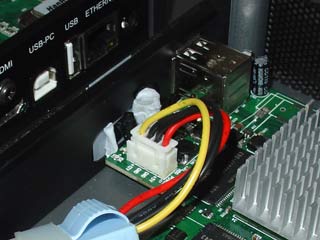
Overall, the A-100 has proved an invaluable addition to our home theater reference system. As it was five months ago, it still isn’t perfect, but for the price and the convenience, we still think it is pretty hard to beat. In fact, the only real long term issue we had with the A-100 was its inability to down mix DTS – Mainly because we refuse to replace our trusty non DTS Onkyo receiver. And here is where the A-110 comes in.
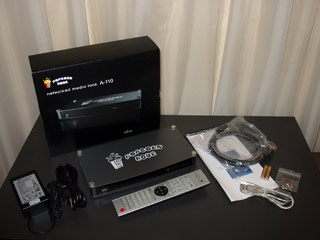 A-110
A-110
Syabas has decided to introduce the A-110 not as a replacement, but as an upgrade to our earlier reviewed Network Media Tank. To this end, the unit is nearly identical visually and the hardware has had only minor tweaks.
The front of the A-110 now features a solitary USB port on the left hand side (as opposed to the two on the A-100) which is joined by a small reset button. While this is a welcome addition – the Popcorn hour does require resetting from time to time – after months of use we have got the remote power then eject button sequence down pat. While it may seem like a good idea on paper, the addition of the reset button is in our opinion a little redundant: Why get up and physically push a button when you can just as easily reset the unit from the couch?
The LEDs on our test unit were also different to the A-100 with five separate LEDs reporting system functions. Our understanding is that these will be replaced by the three standard LEDs on production models, much like the original A-100. The right hand side of the A-110’s front provides the only other clue that this is an upgraded unit, with A-110 replacing the older unit’s A-100 moniker.
The rear of the unit, however, is where things get a little more interesting. The first thing we noticed was that the coaxial S/PDIF port has been replaced by an optical TOSLINK port. While we welcome the inclusion of the optical port, with our old Onkyo 838 receiver as a test bed, we really would really have liked to see both coaxial and optical digital audio ports included.
Continuing our examination of the rear, we find that the missing front USB port has now been placed at the back of the unit. We think this makes more sense, as connecting a wireless dongle (keyboard/WLAN) or an external HD tended to clutter the otherwise neat front. Next to the USB port is USB B port labelled USB-PC. This port introduces the “slave USB” function, whereby a A-110 with a hard drive installed, can be connected to and accessed like any other external hard disk drive. This is handy for filling up the NMT’s (optional) hard drive quickly – particularly if you are unable or unwilling to use the slower port to its right.
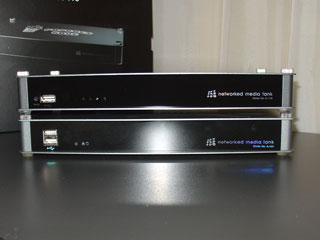
While we had hoped for a Gigabit Ethernet connection, the A-110 features the same 10BaseT100 network connection of the old unit. As we found the standard Ethernet port perfectly adequate for even the highest bit rate media – when using NFS – this is really a misgiving on paper only. And yes, transferring large volumes of data at this speed is frustrating, but the USB slave function should solve this problem for most users.
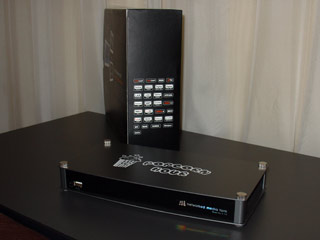
The rest of the ports are identical to the A-100: Component; S-Video; Standard RCA audio/video; and of course, HDMI. While it isn’t obvious physically, the A-110’s HDMI port is compatible with HDMI v1.3, where the A-100’s was not.
Upon opening the unit, we discover Syabas has done a little more than just fiddle with the ports, LEDs and front labeling. The first thing that is immediately apparent is the SATA connection. With IDE on its last legs, SATA was both an inevitable and natural upgrade. When set side by side, we can see the overall design is the same as old A-100 (unit with HD installed) although the circuit board has changed somewhat – The inclusion of a battery being most notable. While our overhead shots don’t show it, the black heat sink on the A-110 is taller than the A-100’s and seems more heavy duty. The other internal change worth mentioning is that the A-110 has mounts for both regular (3.5”) and laptop (2.5”) hard drives: Yet another logical improvement.
The A-110’s remote control is identical to the A-100 and in testing, we found that our original A-100 remote operated the A-110 without any sort of paring.
So from a hardware perspective, the A-110 appears to be a minor – yet overall logical – enhancement of the A-100.
While our unit appears to have come with a higher version of the firmware than is current for the A-100, our understanding is that both units will run the same basic firmware – plus or minus a few features.
Less obvious upgrades include the ability to pass through HD Audio for DTS HD-HR, DTS HD-MA, Dolby Digital Plus and Dolby TrueHD. Due to our antiquated Onkyo reference receiver we are unable to test the ability of the A-110 to pass on these signals. And in any case – the HD pass through feature was yet to be activated with the supplied firmware.
Update 17.09.2008: A firmware update has been released which now allows the A-110 to pass through HD audio.
Another feature that is yet to be implemented but is suggested in the paperwork, is DTS down mixing. With our old Onkyo receiver being one of the last produced without DTS compatibility, this is a welcome feature that was sorely missed on the Popcorn Hour A-100. We wait patiently for this feature to be implemented, but on Syabas’s track record with firmware updates, we have faith that we won’t be waiting too long.
Before moving on to the B-110 it is worth mentioning that save for the aforementioned minor differences, the enclosure of the A-110 is identical to that of the A-100. The enclosure measures 13.5 x 27 x 4cm and is well finished with a glossy front and gunmetal grey aluminium on the top and bottom, just like the original A-100.
B-110
Unlike the two other Popcorn Hour units, the B-110 does not come in a self contained enclosure. Bar some input/output differences, the B-110 is in fact a A-110 Mini-ITX motherboard version of the A-110. It shares all the connectors of the A-110 with the addition of an analogue S/PDIF cable (ala A-100) and also has 7.1 RCA outputs. Despite the numerous RCA ports on the back, our understanding is that only the stereo connectors (labelled STERNO on the metal plate) will be activated in what Syabas calls its B-110 “Baseline” unit.
The B-110 is aimed squarely at AV enthusiasts who can mix and match parts and customise the Popcorn Hour to their particular tastes. The Mini-ITX form factor is designed to fit into any regular Mini-ITX case, and can accommodate two SATA drives along with one IDE unit.
The motherboard has extra USB ports, including internal connectors and comes with its own metal rear plate and external infra-red receiver. Like the A-110, the B-110 also comes with an onboard battery.
Notable Differences
|
A-100 |
A-110 |
B-110 |
|
Sigma Designs SMP8635 chipset 3.5” internal mounts DTS/AC3 pass through *NO DTS down mixing |
Sigma Designs SMP8635 chipset 2.5 and 3.5” internal mounts DTS/AC3/DTS-HD MA/DTS-HD HR/Dolby True HD/Dolby Digital Plus pass through AC3/DTS down mixing. |
Sigma Designs SMP8635 chipsetMotherboard only (Mini-ITX)
DTS/AC3/DTS-HD MA/DTS-HD HR/Dolby True HD/Dolby Digital Plus pass through AC3/DTS down mixing. |
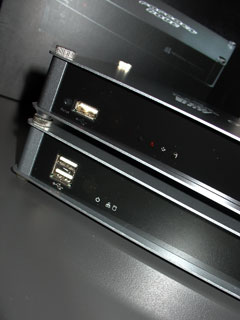 Usage
Usage
While the three units have their own specific differences, our understanding is that they are all operated via the same basic firmware – with added features such as DTS decoding (becoming) available in the A-110/B-110 units.
The only real hiccup we experienced testing these units was one straight out of the box. Upon connecting the NMTs via HDMI cable, our Kuro drew a blank. The loading screen came up okay, but then – nothing. Having used the A-100 for a while we knew that jumping onto the Popcorn Hour community forums would provide a quick solution. And so it did.
It seems that on occasion, the auto-resolution function on the Popcorn Hour units does not manage to negotiate the correct settings with the television, resulting in no picture. The solution was to simply connect the unit via composite and manually set the video – in our case – to 1080P 60Hz HDMI. Annoying, but easy fixed.
As expected, the interface was identical to the A-100 tested earlier this year and from an “on screen” standpoint we were unable to spot a difference.
While our A-110 sample unit had five very bright LEDs, we understand that the production model features only three such LEDS in line with the original A-100. We found the LEDs on the A-110 to be very bright – too bright, really – and while the design has been improved to effectively reduce bleed – we personally found our modded A-100’s bleedless LED lights to be easier on the eye.
The A-110 came with firmware that appeared to be newer than the latest available A-100 firmware we were running, but in usage, noticed no feature changes. While we are not ruling out the placebo effect, fast forwarding and rewinding 1080P MKVs did appear more responsive on the A-110 with the newer firmware. In all honesty, we’re not sure if this is hardware, firmware or just plain imagination. We played back a selection of videos the A-100 would process in its daily routine and found the A-110 to be equally reliable, producing the same silky smooth 1080P our Kuro plasma eats up.
With the firmware being essentially the same at this stage, we will go out on a limb and suggest that other than the physical hardware differences (and soon to be implemented HD audio pass through/DTS decoding) the best indication of how the three Popcorn Hour units perform is in fact our five month or so experience with the A-100 detailed at the start of this roundup.
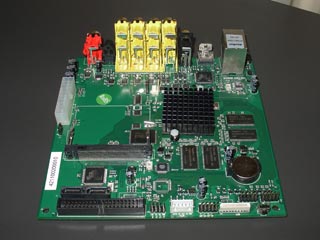 Like the A-110, the B-110 worked identically to the other two units and if it wasn’t for the physical appearance, there would be no way of telling which unit was plugged in to the TV.
Like the A-110, the B-110 worked identically to the other two units and if it wasn’t for the physical appearance, there would be no way of telling which unit was plugged in to the TV.
While we are relegating the A-100 to the back room and moving the A-110 into our home theatre reference room, we generally expect the unit to perform and amaze in much the same way the original Popcorn Hour unit did – albeit with some increased functionality, both now (Slave USB, SATA) and with coming firmware updates (HD audio pass through/DTS down mixing).
Conclusion
The Popcorn Hour units are strong performers and as a range of products are both well priced and feature packed. We really like the old A-100 and while the A-110 is technically superior, the units are both really tailored to two slightly different but entirely similar requirements. If you need DTS decoding and SATA support the A-110 with its other enhancements is the way to go. On the other hand, if you have an old IDE drive lying around and have a DTS equipped amplifier and have little interest for HD audio decoding the A-100 makes more sense. For some, the choice may come down to the type of digital audio interface provided or the availability of what type of old hard drive lying around – For the record, we are sticking to our original 2.5" drive only recommendation. Either way, you are going to get high quality video playback in a neat box.
The B-110 on the other hand is a harder device to sell. It is designed to appeal to the modders who will go out and buy their own power supplies and cases and build a system to their specifications. If you enjoy doing this and you like the Popcorn Hour, then this is the choice for you – And we really like the fact that it has both coaxial and TOSLINK digital audio outputs. The problem with the B-110, however, is that we can’t help but think that those who would prefer to build their own might want to go for something a little more powerful and therefore customizable – think web browsers, etc. On top of this, with even average Mini-ITX cases costing somewhere in the vicinity of $200US, the cost of building your own quickly becomes an expensive venture.
The other sticking point with the B-110 is its unrepresentative 7.1 RCA output ports. In the “Baseline” edition of this variant, these eight ports are deactivated which leaves the overall difference between this and the two enclosed units to amount to form factor, increased hard drive options and dual digital audio outputs. And in the negative, of course, the B-110 has no case.
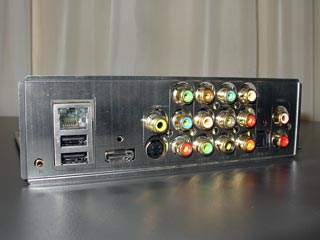
While we are technically not reviewing the A-100, we feel it is worth giving it a score here as its on screen behavior is essentially identical to that of the other units. It’s hardware is also but a shade different and in light of this, we feel our overall experience of the older unit is in fact a pretty fair indication of the potential of the newer ones. The A-110’s new features (DTS, slave USB, SATA) edge out the A-100 but we have deducted marks from the B-110 on account of its increased total cost and its crippled 7.1 outputs.
|
Popcorn Hour A-100 |
Popcorn Hour A-110 |
Popcorn Hour B-110 |
|
7.5 |
8 |
7 |
The Popcorn Hour A-100 is available from the Popcorn Hour online store for $179US while the A-110 and B-110 can be pre-ordered for $215US and $199US respectively.
*To read more of our experiences with the original Popcorn A-100, including more information about the on screen experience, see our original A-100 review.


